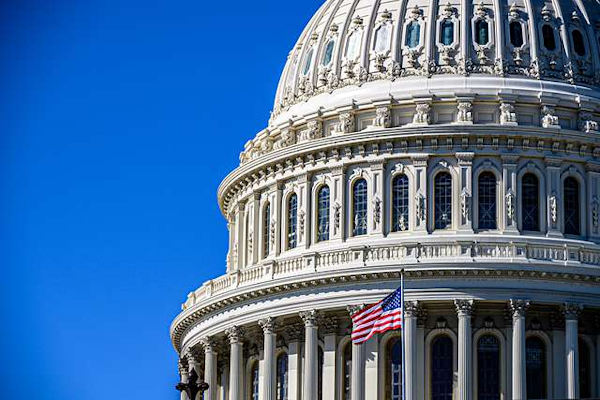SEJournal Online is the digital news magazine of the Society of Environmental Journalists. Learn more about SEJournal Online, including submission, subscription and advertising information.
 |
 |
| Budget battles, including spending for environmental priorities, are expected to be in the news for the coming year. Photo: Defense Visual Information Distribution Service, Public Domain. |
Issue Backgrounder: Why Environmental Reporters Need To ‘Get’ the Budget Process
By Joseph A. Davis
 |
As you try to cover the environment coming into 2024 and beyond, you may need to deal with the federal budget process. That scares many journalists. It should. But no worries — Backgrounder will try to map out a few of its major complexities for you.
Why should you care? Because a few months ago, the United States almost defaulted on the national debt, and in the coming weeks we could see a shutdown as the federal government runs out of money. Arguably, many in Congress believe that it's not money that’s the problem but the government itself, and so their goal is to prevent government from happening.
And if you’re wondering whether spending will be an environment and energy issue in the coming year, consider this: The GOP-led House of Representatives, as it got down to business Nov. 3, passed an appropriation that cut the U.S. Environmental Protection Agency by almost 40%.
Deciphering appropriations rules
Of course, there are extensive rules for funding the government (even if today they may matter little). So let’s start with some basics: Where do rules for funding the government come from?
- U.S. Constitution: The Constitution is the source of almost all federal money powers. A key provision is that the government can’t spend money unless it is appropriated by law. Both the House and Senate have appropriations committees. These are broken down into subcommittees by subject area. Two that environmental journalists track are the Subcommittee on Energy and Water Development and Related Agencies and the Subcommittee on Interior, Environment, and Related Agencies. There are others. Article 1, Section 7 of the Constitution requires that revenue measures must originate in the House, but in practice this has been read to mean appropriations must originate in the House.
- House and Senate rules: Each chamber adopts its own rules. Typically this happens at the beginning of each Congress, by majority vote. See Rules of the House and Rules of the Senate.
- Congressional legislation: Considerations about money, and action on it, have been the focus of political conflict over the nation’s long history. In modern times, the Congressional Budget and Impoundment Control Act of 1974 took another stab at trying to control spending. Honestly, it hasn’t worked that well — except to complicate and obscure the process (more below).
- The Budget Act: This law, mentioned above, set up budget committees in both chambers of Congress, plus a process for “reconciling” spending by appropriations and authorizing committees with a budget. Because reconciliation only takes a simple majority of the Senate, it has become a way around the cumbersome Senate filibuster rules, which require 60 votes. Controlling spending? Not so much. The Budget Act was meant not only to limit overspending but to prevent the executive branch from refusing to spend what Congress appropriates. This was actually an issue back in the 1970s; presidents have tried to “impound” and “rescind” spending by Congress.
Deadlines vs. timelines
Deadlines? Think of them more as suggestions. But all the rules do outline a sort of timeline that both the executive and legislative branches are supposed to follow. Sometimes they actually do.
- President’s budget: Traditionally, the president presents a detailed program-by-program budget proposal to Congress near the start of each calendar year. The press makes a hullabaloo, politicians make speeches and then Congress often ignores it (especially during divided government). But it does serve as a sort of benchmark for spending goals.
- Authorization legislation: By custom and Congressional rules, “authorizing” legislation must be passed before money can be appropriated. Authorizing legislation describes federal programs and sets limits on spending. Surprisingly, this rule is mostly followed (even if the appropriations committees have to include authorizations in their bills). Sometimes the authorizing legislation sets “mandatory” spending like Social Security, which does not require an annual appropriation.
- Appropriations: Theoretically, Congress is supposed to pass 12 separate appropriations bills annually (one for each subcommittee) and send them to the president by Oct. 1, the beginning of the federal fiscal year. In modern times, this rarely happens. Instead, Congress often gets hung up on politics and misses the deadlines. Without appropriations, the government will shut down. It has done so often in recent years.
- Continuing resolutions: To prevent a shutdown in a pinch, Congress often passes “continuing resolutions” known as CRs. These typically continue appropriations at funding levels of the previous year, but for a fixed (usually short) period of time, while Congress gets its act together.
- Supplemental appropriations: In many years, unforeseen emergencies call for unplanned spending — such as this year’s aid to Israel for the war with Hamas. This is done via “supplemental” appropriations.
- Omnibus appropriations: Sometimes (as the chaos and desperation mounts) Congress lumps all the appropriations into a single bill called the “omnibus” appropriation. Sometimes these are CRs as well. Because so many committees and interests are involved, it is an opportunity for political horse-trading. Sometimes, however, these mega-bills are so big they become unwieldy. So in recent years, Congress has started creating sub-groups of appropriations called “minibus” bills. The name is cute. Explaining it is hard.
Is a deal really a deal?
Even though you need to know the rules about money, you also need to remember that at bottom it’s really about politics. They say a deal is a deal — but is it really?
For example, when the government faced financial catastrophe with the expiration of the federal debt ceiling in the most recent (May 2023) crisis, the crisis was settled by a deal (may require subscription).
The principals in that deal were really President Biden and then-Speaker Kevin McCarthy, R-Calif., although others were also involved. One thing McCarthy got in exchange for extending the debt limit was a commitment from Biden (and thus Dems) to certain spending cuts (the GOP ask).
Crisis was averted — but since then many far-right GOPers have demanded more cuts. McCarthy is now gone from the speakership. Welcome to Washington.
Over the years, veteran Hill reporters have watched, during long stake-outs, as member after member reverently entered the office of an appropriations subcommittee chairperson for a long meeting. Shades drawn. The final bill subsequently included some “pork” for the member — who joined the often-unanimous members voting for it.
This process is hard to observe because
the draft subcommittee appropriations bill
is rarely released before the moment
the subcommittee meets to vote on it.
This process is hard to observe because the draft subcommittee appropriations bill is rarely released before the moment the subcommittee meets to vote on it. Seats in the tiny subcommittee room are hard to come by, and these actions are often covered by a pool reporter. Meanwhile, the bill is long, complex and obscured by legal language.
Helpful guides and primers
If Congressional spending rules make you feel dizzy, you are not alone. Look for the helpers, as Mr. Rogers would say. There are many primers available.
For example, the Congressional Budget Office, which officially “scores” the impact of money bills. The CBO focuses mostly on issues that arise under the Budget Act processes. Since the outcome of many Congressional actions depends on the overall economy, their experts are often economists. Here’s one explainer from CBO.
The Congressional Research Service is a nonpartisan group of experts working for Congress (under the Library of Congress) that produces many research reports in plain English, often at the request of members. Here’s its overview of the spending process and a recent explainer it did on the rules of the Budget Act.
The Government Accountability Office is a nonpartisan arm of Congress, to which members can send requests for research and reporting — not always on spending matters. Here is one recent explainer GAO did on federal spending rules and procedures.
The Office of Management and Budget should be a helper, but isn’t really. OMB is located within the Executive Office of the President. The main thing reporters get from OMB is the official text (plus briefing) on the president’s annual budget proposal. Its press operation has been pretty untransparent through many past administrations of both parties.
It is nonetheless a power center through which the president exercises control over agencies. In the past, it has also been an untransparent back channel by which lobbyists (both industry and green) can influence agency regulatory decisions. The Biden OMB has tried to make that process more transparent.
There are a lot of others. Here are various primers from the National Science Foundation, Bloomberg News, the federal executive branch information site USA.gov, the (Trump) White House, The Washington Post and the House Budget Committee.
Joseph A. Davis is a freelance writer/editor in Washington, D.C. who has been writing about the environment since 1976. He writes SEJournal Online's TipSheet, Reporter's Toolbox and Issue Backgrounder, and curates SEJ's weekday news headlines service EJToday and @EJTodayNews. Davis also directs SEJ's Freedom of Information Project and writes the WatchDog opinion column.
* From the weekly news magazine SEJournal Online, Vol. 8, No. 41. Content from each new issue of SEJournal Online is available to the public via the SEJournal Online main page. Subscribe to the e-newsletter here. And see past issues of the SEJournal archived here.












 Advertisement
Advertisement 



